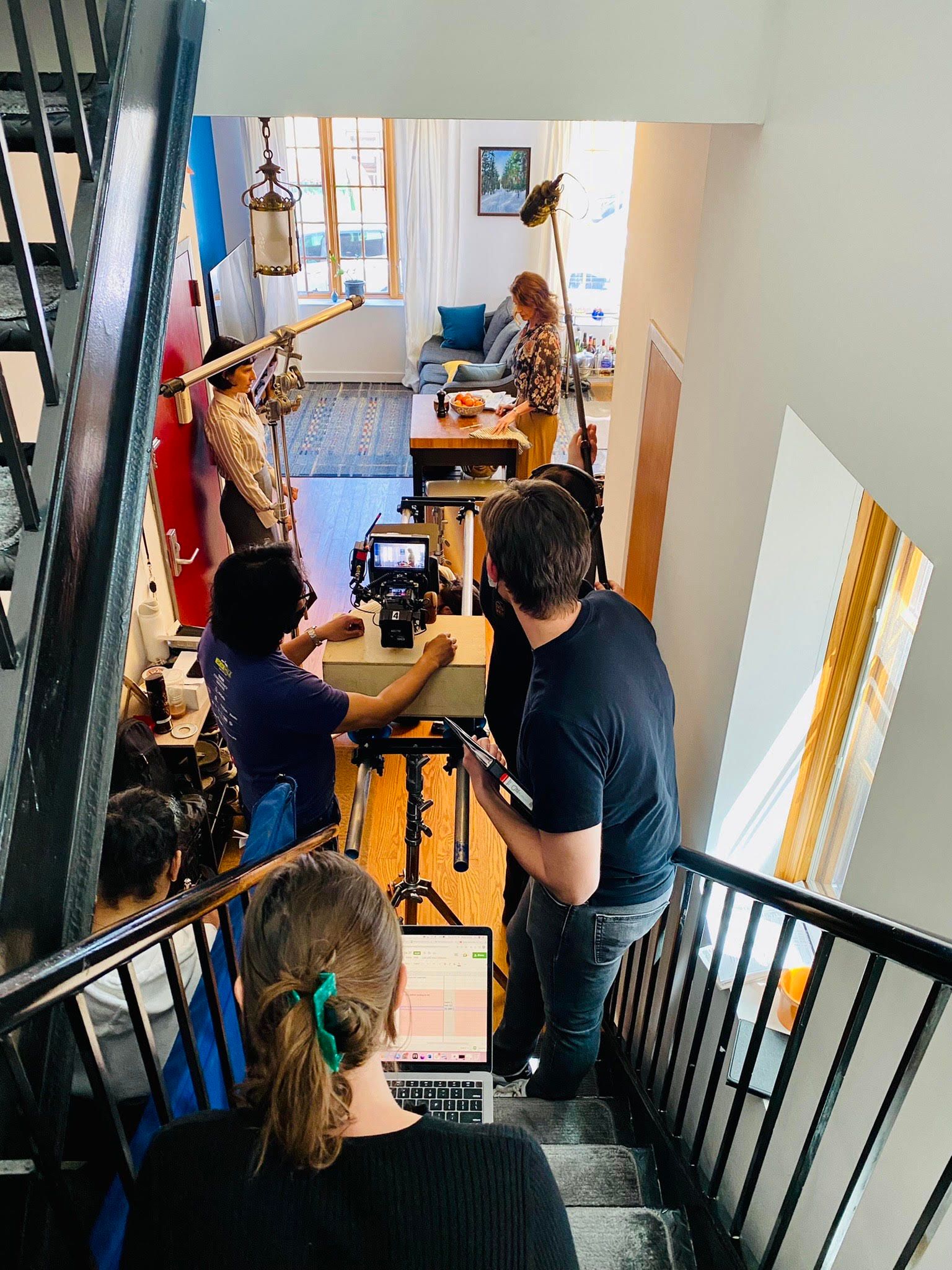
How To Make a Short Film Without Going (Totally) Crazy
There’s no right way to make a film, but there are things you can do to help it go more smoothly.
A short film can be creatively fulfilling, a way for a writer or director to start bringing their vision to life, and—if it’s successful—a gateway into the film industry. Unfortunately, just because a film is short doesn’t mean that it’s easy or cheap to produce. Like any film, it’s a complex, potentially stressful, and complicated undertaking. Fortunately, you aren’t doing it alone, and there are concrete tactics that will help your production go smoothly and your vision come to life.
I completed principal photography on my second short film, a spy thriller called Sleepers, in April 2022. While my first film (Crossing Acheron) had been an extreme exercise in limitations—pre-vaccine COVID restrictions, a budget of $3,000, a crew of four (including me), and one on-screen actor (complimented by voice actors)—the script for Sleepers required a larger production.
The challenges were threefold:
- I’m a writer first, so I wanted to increase my comfort level with directing and producing.
- Writing, directing and producing is a lot for one person to take on.
- The script required five actors, prop guns, and briefly closing a New York City street.
- I financed the film myself. This meant that not only were resources limited, but it was my own money on the line. Getting things right was the only option.
Despite these challenges, the shoot went incredibly well. Hopefully, there are some useful takeaways for other filmmakers producing their first films.
Here’s how we got it done:
Take preproduction seriously: In a lot of ways, preproduction is the most important phase of making a film. It’s when you solidify your budget, refine your script and enlist your crew, cast and support people. The smaller the production and budget, and the more roles you are playing, the more time you need to allow yourself for preproduction.
It’s a bit like planning a wedding; there are a lot of details. The more potential problems and challenges you identify ahead of time, the better prepared you will be during the shoot. You should absolutely use preproduction as an opportunity plan for things that could go wrong. Game them out, and figure out how you’ll solve issues during the shoot or in post-production.
Location, location, location: Identifying your locations early in preproduction will give you an advantage in every other aspect of planning. Locations shape the types of resources you’ll need, the amount of time you’ll need for each setup, shot and scene, and how far your budget will go. Sleepers had three main locations: The interior of a house or apartment, an exterior of that house or apartment, and a playground or park.
Initially, we secured a private home that on paper was the perfect location. It was a home in suburban New York in a Frank Lloyd Wright planned community. Visually, it’s stunning, and it meant that we would be able to shoot the exteriors on private property, which made the use of prop guns easier.
However, as we refined the budget, it soon became obvious that the logistics of getting a crew of twelve plus five actors to the house for three days of shooting were quite complicated. To shoot at the location—1–2 hours outside of New York City depending on traffic—we would have had to coordinate vans or car service for the actors, crew and all of the equipment.
While the location itself was inexpensive, the costs of getting the necessary equipment and people to it completely blew the budget. Moreover, we soon became concerned that if we had a problem—missing or broken equipment for instance—we could wind up massively behind schedule while trying to find a replacement in a relatively rural location.
Rewrite: Rather than expanding the budget—something which simply wasn’t possible—I went back to page one with a rewrite. The goal was to transpose the story from a suburban setting into an urban one. The new script was set in Brooklyn, where most of the cast and crew lived, and where I had access to an apartment. This drastically cut down on transportation costs and the time needed to get between locations.
When we finally got to shooting, this decision probably saved the film: Two hours into the first of three days of photography, a tripod broke. (I know, I know, how does that even happen? Trust me, the DP was in shock.) Fortunately, the new location was a mere 10 minutes away from the rental house where we had rented the rest of the equipment. Since we already had an order there and our insurance was pre-approved, the broken tripod only delayed the shoot by 30 minutes.
Get creative help: Filmmaking is an incredibly collaborative process. Of course, it’s always possible to just hire a crew, but your film will be so much better if you engage people creatively.
What does this mean?
Make sure everyone is invested in the story you’re telling. I had the benefit of an incredible cast and crew. Without them, the production would have been a failure. Everyone one of them asked to read the script before agreeing to join the cast or crew, and every single person either had questions or feedback about it. The few times that I interviewed potential crew members who did not ask questions or start with a discussion of the script, I did not invite them to join the production. Additionally, every member of the crew came via a recommendation from someone else.
Ideally, everyone involved in a film is a creative collaborator. First and foremost, they need to be people who are creative and who want the vision to succeed. Not only that, everyone needs to see the film as being, in part, a product of their vision. By ensuring that everyone was creatively engaged, we were able to make the script and the shoot better, because everyone was bringing their unique skills and insights to it. In fact, a note from our hair and makeup artist (Jazmin Patiño) completely changed how we shot a complicated assassination scene, streamlining out setups and building additional suspense into the final scene.
Key players: Everyone on a crew is important to the production, but starting in preproduction, there are two key relationships that you need to develop right away. One is with your director of photography (DP). I brought on my DP (HJ Kim) before anyone else, and he was deeply involved in shaping the shooting script, sorting out logistics around locations and how we would shoot them, and helping to define the schedule and crew. How we shot the film impacted the type of equipment we would need (costs), who we needed in the crew (costs), and how long each scene would take to complete (costs). Having a DP who I trusted and who was creatively simpatico was an absolute necessity.
The second key role to fill very early on is a producer. Now, I was producing the film by myself, but I realized very quickly that there was a huge amount that needed to be coordinated during preproduction and on set, and that I was spread too thin. Rather than bring on an assistant director, I engaged a talented, hands-on producer (Molly Loftus), who could help with preproduction and also with running the set during the shoot itself. This meant that I had a reliable collaborator all the way through, and that once we started shooting, I could focus on the actors and camera with the knowledge that she understood everything else that needed to happen.
Use your network: My DP, producer, HMU and costume artist, 1st AC, craft services, and one of my actors were all people I had worked with before. It’s important that you understand the strengths of your crew, however. My producer hadn’t had any experience on a narrative film, but I had worked with her before professionally in a different industry, knew she was very organized, and knew that she had ample experience running corporate video shoots. She was an All Star on the production. We also needed a specific lighting setup that was very expensive to rent; an established filmmaker who knew us donated the lights for the shoot in exchange for a “special thanks” credit.
Set budget tiers: It’s incredibly important to have a budget for your film, but it shouldn’t feel like shackles. Figure out the maximum amount you can spend on your film (regardless of its source), and then work backwards. I set an aspirational budget—a low number that I hoped to hit—then defined a median level where I actually expected the budget to be. Then I set the actual total amount of funds available as the maximum we could spend.
During preproduction we quickly blew past the aspirational number, which we had expected. However, by having it in mind, it forced us to think hard about our expenditures, including the locations, which saved us time and headaches later on. Instead, we hit the expected budget dead-on, which left us with some extra margin. Having extra padding in your budget is important, because things never go exactly as expected. We had to rent an extra tripod, for instance. One night, our shoot ran over by several hours, but we were able to compensate for it by ordering car services for the cast and crew.
Crafty matters: If you’re working on a budget, it can be tempting to cut expenditures on craft services. Don’t do it! Keeping your actors and crew well fed, well caffeinated, comfortable and happy makes the entire shoot more pleasant and more efficient. Money spent on taking care of your people is money well spent. It’s almost always better to cut unnecessary “nice-to-have” items from the equipment budget or find ways to streamline locations.
Don’t wait for permits: Lastly, take care of permits early on. We were using prop guns (non-firing) for our shoot. Initially, when we were shooting at the suburban home, we weren’t going to need any sort of permits, because we would be on private property the entire time. However, once we moved the shoot into New York City, we discovered that we would need a permit to use the props on the street and that a liaison officer from the NYPD was required. Because our production was small, we struggled to get our permit from the Mayor’s office. With time running out, a staffer from local City Council Member Alexa Aviles’ office helped us secure our permit, and the needed NYPD officer, in time. We were able to use the props safely and control traffic on a city street as result.
These are just a few lessons we learned on our shoot. Every film is different, and every filmmaker’s experience will be different as well. Regardless of the circumstances, however, careful planning and being selective about your cast, crew and partners will help make any shoot more fun and creatively successful.
*Feature Photo: The cast and crew of “Sleepers” prepare to shoot a dialogue scene. Credit: Mary Florence Sullivan
Screenwriter and Producer Kay Tuxford will walk you through step-by-step how to choose a good first film script to write, produce, and get your short in front of an audience in her Symposium session, Making Your First Short Film.
